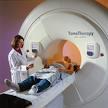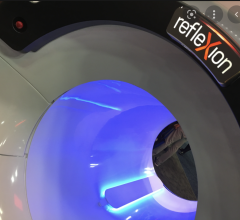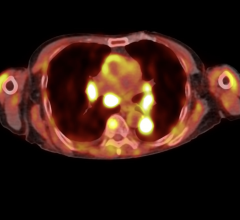
April 9, 2009 – Better tumor control and possible survival improvement may be achieved safely with preliminary results of an ongoing Phase I clinical trial on the use of intensity-modulated (IMRT) and image-guided radiation therapy (IGRT) focusing on the concept of accelerated hypofractionation to overcome tumor repopulation, one of the well-known mechanisms of radiation resistance, using TomoTherapy for non-small cell lung cancer (NSCLC).
The paper, published in the Technology in Cancer Research and Treatment (Technol Cancer Res Treat. 2008 Dec;7(6):441-8.) titled, “Dose Escalated, Hypofractionated Radiotherapy Using Helical Tomotherapy for Inoperable Non-Small Cell Lung Cancer: Preliminary Results of a Risk-Stratified Phase I Dose Escalation Study,” evaluates a study devised to test the safety of escalating the biologically-effective tumor dose via hypofractionated treatment regimens using 25 fractions over five weeks. Traditionally, radiotherapy is delivered over six to seven weeks, or even longer (sometimes up to 10-11 weeks) if dose-escalation is the goal. A downside to dose escalation in this manner is that tumor repopulation occurs during the prolonged delivery time. Shorter dose-escalated schedules have historically been avoided because of the expectation of severe toxicities. The University of Wisconsin (UW) School of Medicine and Public Health investigators hypothesized that the conformal dose-delivery abilities of TomoTherapy, with helical IMRT and IGRT, would permit safe dose-escalation with shorter schedules, thereby limiting accelerated repopulation, and possibly improving tumor control.
According to its authors, the study demonstrates that the use of TomoTherapy technology may allow for higher doses of radiation therapy than are conventionally administered to be delivered over a shorter treatment course, with lower than expected toxicities. Helical TomoTherapy allows for delivery of image-guided, intensity-modulated radiation therapy, permitting conformal delivery of radiotherapy while minimizing the dose delivered to normal tissues.
“The early results of this study suggest that a hypofractionated schedule with dose-escalation can safely be achieved and, although preliminary, the survival data look promising,” said senior author Minesh Mehta, M.D., radiation oncologist and professor of Human Oncology at the UW School of Medicine and Public Health. “Preliminary results suggest that better tumor control and possible survival improvement may be achieved safely with this method, compared retrospectively with traditional radiotherapy techniques.”
Calculations predicting the likelihood of lung toxicity, along with constraints on maximum esophageal and spinal cord dose, were used to help customize the total dose and dose per fraction given to each patient. Doses between 57 and 80.5 Gy were delivered in fraction doses of 2.28-3.22 Gy, representing equivalent doses in 2 Gy fractions of 60-100 Gy.
Promising Preliminary Results:
o For the 46 patients in the study, 80 percent of whom had stage III NSCLC, overall survival 2 years after treatment was 46.8 percent. Stage-for-stage, this compares with a 2-year survival rate of 21.5 percent from a database representing all clinical, surgical-pathologic, and follow-up information for 5,319 patients treated for primary lung cancer.
o Higher doses of radiation therapy than are conventionally administered (typically ~60 Gy in 2 Gy fractions) may be delivered safely in a hypofractionated schedule with helical TomoTherapy. Reported lung and esophageal toxicities are lower than expected from previous dose escalation studies using conventional radiotherapy technology.
o No patient experienced grade 3 or higher pneumonitis. Grade 2 pneumonitis occurred in only 13 percent of patients in this study. This illustrates one of the major safety parameters of the study.
o No patients experienced grade 3 esophagitis. For those developing esophagitis of grade 1 (24 percent of patients) or grade 2 (13 percent) an average weight loss of under 3 percent occurred. In a University of Michigan dose-escalation study utilizing 3-D radiotherapy, and a non-hypofractionated approach to dose-escalation, grade 1, 2, and 3 esophagitis occurred in 39.5 percent, 16.5 percent and 2.7 percent of patients respectively. The esophageal dose constraints used in the protocol have since been relaxed, given the low incidence of significant esophagitis.
o Statistical analysis showed that mean dose to normal lung is a predictor of the rate of lung pneumonitis, but that dose prescribed to the tumor is not. This indicates that the methodology for safe dose prescription based on predicted normal tissue toxicity is valid. The maximum tolerated dose has not been reached and the protocol continues to accrue patients.
Says Rock Mackie, Ph.D., founder and chairman of TomoTherapy and a UW School of Medicine professor, “While it’s still early in the process, we are pleased and encouraged that the results of the study demonstrate that treatment can be delivered in higher doses and in shorter periods of time. This is a promising result which makes us hopeful that there will be improvement in the way non-small cell lung cancer responds to treatment and can be managed moving forward.”
For more information: www.tomotherapy.com


 July 09, 2024
July 09, 2024 









